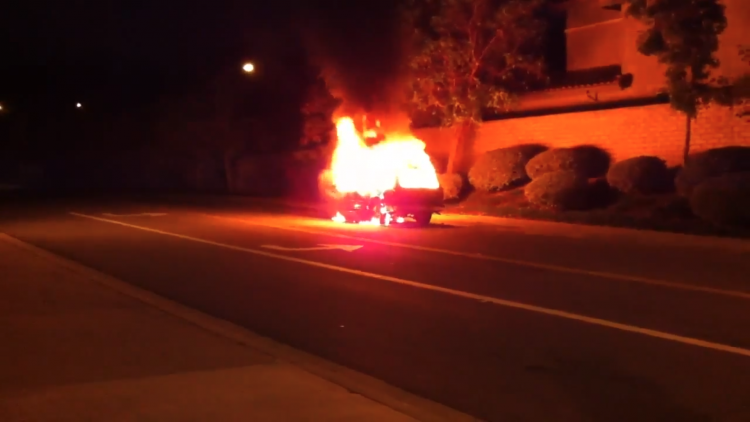Sable Elyse Smith: FEAR TOUCH POLICE | Art Agenda
Jan 22 2021

A short clip functions as the backdrop for Sable Elyse Smith’s multimedia project in three issues—“FEAR TOUCH POLICE”—commissioned by the Swiss Institute and exhibited on a dedicated website. It is roughly 18 seconds of footage showing a solitary car parked by the side of a road at night engulfed in flame. After 14 seconds the car explodes, the camera jolts and then restabilizes. Then the clip resets.
The fire is omnipresent as I scroll down through the five entries that make up “Issue one: FEAR.”1 I zoom into Jibade-Khalil Huffman’s poem, which is printed in infinitesimal letters to the right of the screen, and the fire is there. It explodes around the edges of the embedded screen on which plays Johan Grimonprez’s classic montage film dial H-I-S-T-O-R-Y (1997). “If you are reading this, then you have found yourself in a time consumed by crisis,” writes Jessica Lynne in her contribution entitled “A letter written on a day without the sun,” and the car explodes in the background. Several paragraphs later she writes about her wish for a “place that is not riddled with food insecurity or housing instability or extrajudicial murder or…” and the car explodes again.
Neither the fire nor the explosion is a shock; it is just the ground for Smith’s work of synthesis and juxtaposition, of building tension and allowing it to temporarily release. And it is the ground for this moment in the history of the US. Like the camera that jolts but then immediately recenters on the image of the car in anticipation of the next explosion, like the boxers’ bodies in Paul Pfeiffer’s Caryatid (2015–20) who take an invisible blow, struggle for balance, then take another, the viewer knows what is coming.
Or does she? The final lines of Jibade-Khalil Huffman’s poem read, “my life / is the opposite of yoga / the same as / jogging when / someone is chasing you,” begging a question that Smith asks twice in her own poetic introduction to issue one: “Do you know this?” Which is to say: is this violence and the fear it instills actually known to you? dial H-I-S-T-O-R-Y was made four years before 9/11, and so its plotted history of plane hijacking as an instrument of international terrorism reads in retrospect like an established visual fact that was somehow ignored. The semiotic history was there in plain sight, yet those with the power to do something were insulated from its effects by privilege, and therefore they did not know, not in the sense that Smith means. They did not recognize the threat of violence and so they did not know fear.
Smith’s 2017 essay “The Sound is the Picture” prefigures both the compositional logic of “Issue one: FEAR” and its preoccupation with an inexorable, structural anxiety.2 In it, she describes watching three children play together on a train. “They are my complexion,” she writes. “The youngest boy says: oh shit, I still have one more life because I didn’t know. This is a game where they give each other many lives.” This is a game in which violence exists but does not stop the game. “And I just think You,” Smith writes, “you are not allowed to not know.” There are children who must know how many lives they have at their disposal in the game, and that fact is violent. So when Smith asks the viewer “Do you know this?” she is not asking them what they know. She is asking them about their position: that which conditions their capacity to know, on an existential level, what violence is.
Smith’s virtuosity is grounded in her understanding that the image does not suffice to instill this knowledge, thus “Issue 1: FEAR” is a complex layering of sound and image, of visual and sonic tension. Alice Coltrane’s Journey in Satchidananda (1971) accompanies Jessica Lynne’s text, subtending her warning without illustrating it. In a text that Smith commissioned, the musician Jason Moran writes: “It has always been within the humble square footage of a stage that Black performers have battled not only stage fright, but also the fears of those they perform for and against.” Fear is multidirectional, in other words, and Moran’s point is that the Black performer is caught in its crossfire. He is articulating a position in the chasm between those who know violence and fear it and those who knew the blow was coming, knew the semiotics of plane hijacking, knew the car would explode, but were never forced by structural violence to take that knowledge into themselves. Perhaps it is time everyone understood that they are not allowed not to know fear. Because when you do not know this, you force others to carry that knowledge in addition to their own, and that is violence.
Natasha Marie Llorens is an independent curator and writer based in Stockholm. She is Professor of Art and Theory at the Royal Institute of Art and a core tutor at the Piet Zwart Institute in Rotterdam.
